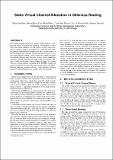Static virtual channel allocation in oblivious routing
Author(s)
Shim, Keun Sup; Cho, Myong Hyon; Kinsy, Michel A.; Wen, Tina; Lis, Mieszko; Devadas, Srinivas; ... Show more Show less
DownloadACFAB2FCd01.pdf (255.8Kb)
OPEN_ACCESS_POLICY
Open Access Policy
Creative Commons Attribution-Noncommercial-Share Alike
Terms of use
Metadata
Show full item recordAbstract
Most virtual channel routers have multiple virtual channels to mitigate the effects of head-of-line blocking. When there are more flows than virtual channels at a link, packets or flows must compete for channels, either in a dynamic way at each link or by static assignment computed before transmission starts. In this paper, we present methods that statically allocate channels to flows at each link when oblivious routing is used, and ensure deadlock freedom for arbitrary minimal routes when two or more virtual channels are available. We then experimentally explore the performance trade-offs of static and dynamic virtual channel allocation for various oblivious routing methods, including DOR, ROMM, Valiant and a novel bandwidth-sensitive oblivious routing scheme (BSORM). Through judicious separation of flows, static allocation schemes often exceed the performance of dynamic allocation schemes.
Date issued
2009-05Department
Massachusetts Institute of Technology. Computer Science and Artificial Intelligence Laboratory; Massachusetts Institute of Technology. Department of Electrical Engineering and Computer ScienceJournal
Proceedings of the 3rd ACM/IEEE International Symposium on Networks-on-Chip (NoCS 2009)
Publisher
Institute of Electrical and Electronics Engineers
Citation
Static virtual channel allocation in oblivious routing
Keun Sup Shim; Myong Hyon Cho; Kinsy, M.; Wen, T.; Lis, M.; Suh, G.E.; Devadas, S.;
Networks-on-Chip, 2009. NoCS 2009. 3rd ACM/IEEE International Symposium on
10-13 May 2009 Page(s):38 - 43
Version: Author's final manuscript